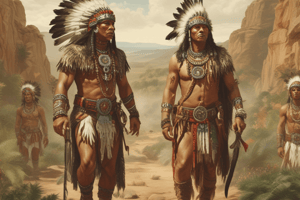Podcast
Questions and Answers
What was the estimated population of America before European arrivals?
What was the estimated population of America before European arrivals?
- 20,000
- 1 million
- 4 million (correct)
- 10 million
Which agricultural practice was developed by the Native Americans?
Which agricultural practice was developed by the Native Americans?
- Maritime agriculture
- Three-Sister Farming (correct)
- Hydroponic farming
- Single-crop farming
Who were the first known European discoverers of America?
Who were the first known European discoverers of America?
- Christopher Columbus
- The Spanish
- The French
- The Vikings (correct)
What was one of the significant technological advancements made by Portugal for exploration?
What was one of the significant technological advancements made by Portugal for exploration?
What fueled the demand for imported goods in Europe during the Renaissance?
What fueled the demand for imported goods in Europe during the Renaissance?
What was one effect of the population decline in Europe during the Black Death?
What was one effect of the population decline in Europe during the Black Death?
What was the primary motivation behind the exploration advancements in Portugal?
What was the primary motivation behind the exploration advancements in Portugal?
Which of the following best describes the condition of North American tribes at the time of European arrival?
Which of the following best describes the condition of North American tribes at the time of European arrival?
What evidence suggests the migration patterns of the early inhabitants of America?
What evidence suggests the migration patterns of the early inhabitants of America?
Which civilization was known for its advanced agricultural practices, particularly the cultivation of maize?
Which civilization was known for its advanced agricultural practices, particularly the cultivation of maize?
What is a notable feature of the Anasazi civilization in North America?
What is a notable feature of the Anasazi civilization in North America?
Which of the following characteristics define the Mississippian Culture?
Which of the following characteristics define the Mississippian Culture?
What factors contributed to the development of civilizations in Central and South America?
What factors contributed to the development of civilizations in Central and South America?
Which statement about the Aztec civilization is true?
Which statement about the Aztec civilization is true?
What is a significant feature of the Cahokia settlement in the Mississippi River Valley?
What is a significant feature of the Cahokia settlement in the Mississippi River Valley?
What is one mystery surrounding the Anasazi civilization?
What is one mystery surrounding the Anasazi civilization?
Flashcards are hidden until you start studying
Study Notes
Native America Before Columbus
- Estimated population: 54 million in North and South America upon Columbus' arrival.
- Migration theories suggest some used crude boats, potentially from Europe, while most crossed the Bering Strait land bridge (Beringia) as nomadic hunters and gatherers.
- Migration led to the formation of countless tribes, over 2,000 languages, and rich diverse cultures and religions.
Development of Civilizations
- Advanced agricultural practices, especially maize cultivation, spurred growth of sophisticated civilizations in Central and South America.
- Key civilizations included:
- Incas: Located in Peru.
- Mayans: Resided in Central America.
- Aztecs: Predominantly in Mexico, with an estimated population of 20 million.
- Achievements included elaborate cities, extensive trade routes, complex languages, numerical systems, and accurate calendars.
- Religions were polytheistic; human sacrifices, particularly by the Aztecs, were a common practice.
North American Civilizations
- Civilizations north of Mesoamerica were less elaborate but significant.
- Agricultural development was inconsistent, first flourishing in the Southwest with the Pueblo culture and irrigation systems.
- The Anasazi were the oldest known civilization, known for:
- Agriculture focusing on corn and grains.
- Permanent settlements with stone/adobe structures in Chaco Valley and Mesa Verde.
- Mysterious disappearance circa 1300 AD, possibly due to drought or warfare.
- Mississippian Culture thrived in the Mississippi River Valley, notable for burial mounds and Cahokia being the largest settlement in North America (estimated 20,000 population).
- Developed "Three-Sister Farming" (squash, beans, and corn) and descendants included the Creek, Choctaw, and Cherokees.
- By the time of European arrival, most of North America was sparsely populated with small, impermanent villages, estimated total population around 4 million, and land ownership concepts were absent.
European Exploration Boost
- Vikings were the first Europeans known to explore America, settling in Vinland (Newfoundland, Canada) around 1000 AD.
- In continental Europe, awareness of the Americas was minimal; survival concerns dominated due to events like the Black Death.
- Factors leading to increased exploration included:
- Population growth post-Black Death.
- Renaissance sparked curiosity and questioning of the world.
- Emergence of new merchant classes due to demand for exotic goods from Asia due to Marco Polo and the Crusades.
Portugal's Maritime Ascendancy
- Portugal advanced navigation with the creation of the Caravel, enabling better sailing—particularly into wind and shallow waters.
- Key figures include:
- Prince Henry the Navigator: Advocated for exploration, established a navigation school.
- Bartolomeu Dias: Rounded the Cape of Good Hope (1486).
- Vasco da Gama: Reached India in 1498, enhancing Portugal's wealth through spice trade.
- Portugal became a dominant maritime power, fostering envy and competition among European neighbors, especially Spain.
Studying That Suits You
Use AI to generate personalized quizzes and flashcards to suit your learning preferences.




